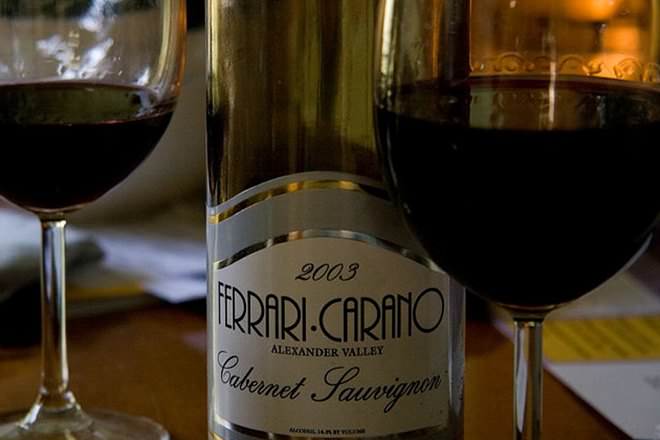Cabernet and Chardonnay are different types of grapes that are used to produce two different types of wine. Cabernet Sauvignon is a rich bodied, red wine made from the Cabernet Sauvignon variety of grapes. Chardonnay is a white wine made from a green-skinned grape variety called well, Chardonnay.
Comparison chart
Origin
In the late 1990’s, Cabernet Sauvignon traced it origins to an offspring of Cabernet franc and Sauvignon Blanc. Before this, the source was assumed to be the Biturica, which was used in the making of ancient Roman wine. Amongst other stories, some even believed that its origin lay in the Rioja region of Spain.
Chardonnay also has many different stories regarding its origin. People claimed its source to be the Pinot noir or the Pinot Blanc. Some viticulturists also proclaimed that Chardonnay wine descended from the Vitis Vinifera vine. Speculation rose and vineyard owners in Lebanon claimed that the grape could have been sourced from the Middle East as well. However, with the help of modern research, scientists verified the origin to a cross between the Pinot and Gouais Blanc to be the exact source.
Viticulture
Climate plays an essential role in the harvesting of Cabernet Sauvignon. Regions in California allow plentiful sunshine to ensure that healthy Cabernet is produced. However, in Bordeaux, the vine is harvested slightly earlier before the actual harvest season. The grapes are later blended in with other varieties, to add to its flavor. When transformed into wine, the flavor of the wine changes from ‘bell pepper like’ to ‘stewed black currants,’ as the vine is exposed to more warmth. Since it can grow in a wide variety of soil types, new age wine makers do not particularly worry about that aspect of wine-making.
Since Chardonnay wine adopts most of its flavors from the ideally harvested grapes, it becomes essential for viticulturists to ensure that the vine is not subjected to frost or other harming elements. As an early budding vine, a new method of pruning them just before flowering, gives Chardonnay a two week ‘stay’ prior to flowering. It can usually sustain itself places that have short growing seasons and are harvested before the autumn rain in Burgundy. Soil is not a major concern here either, but the vine is preferential to clay, limestone and chalk.
Regions
Cabernet Sauvignon has a history with the region of Bordeaux, since that is its likely birthplace. Other regions that see production of this vine and subsequent wine varieties include Italy, Spain, United Kingdom, Georgia, Hungary, Romania, Cypress, Greece, Israel, Lebanon and many others. Within America, one can see varieties of the wine in California, Eastern Washington, Oregon, Arizona, and New York. In South America, Chile, Argentina, Peru, Bolivia and Uruguay are well known countries that indulge in vine producing.
France is an important region that produces Chardonnay. One can also find it in Burgundy, Chablis, Champagne and Limoux. In North America, Chardonnay is grown in California, Oregon, Texas, Virginia, Illinois, Indiana, Iowa, Maryland, New York, North Carolina, Oklahoma and Minnesota. It is also found in Australia, New Zealand, Italy, South Africa and Canada.
Popularity
Cabernet Sauvignon is widely accepted as one of the noblest grape varieties. Consumers have willingly accepted wine produced from Cabernet Sauvignon variety. However, since the ease of producing this variety of vine, many people have ignored the local grape produce, giving Sauvignon its ‘colonizer’ status.
Chardonnay wine was widely accepted in the 1980s for a lot of reasons. However, in the 1990s, the trend reversed and people demanded ABC –Anything But Chardonnay for wine.
Food Pairings
Since Cabernet Sauvignon has a high affinity towards oak and is quite dominant and bold in nature, it doesn’t mix well with delicate flavors. When the wine is young, alcohol content, high tannin content and the oak influences are at their peaks which make it difficult to pair it with foods outside its compatibility. However, with age, the wine matures and a lot of other combination options open up. It doesn’t mix well with spicy food but responds well to mild spices like pepper and fats. Proteins and bitter foods also are good options to team the wine with.
Chardonnay can usually be found on tables with salmon, seafood, chicken and other white meat. However, it can also be paired with tomato based dishes, sweet onions, mushroom soup and other earthy dishes.




 Jack Daniel's
Jack Daniel's  Port Wine
Port Wine  Merlot
Merlot  Bourbon
Bourbon  Ale
Ale
Comments: Cabernet Sauvignon vs Chardonnay